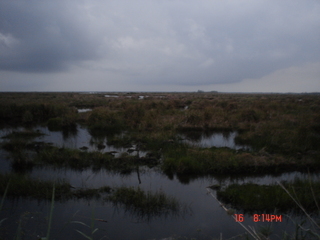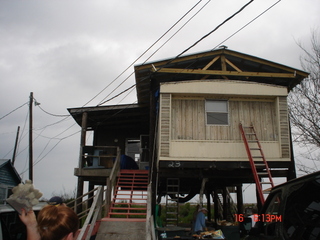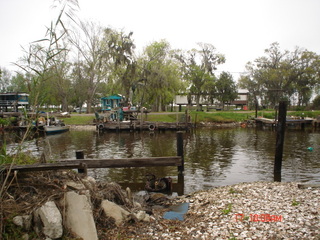( – promoted by navajo)
This is a cross-post of something I just did over on Daily Kos. One of the people there suggested I post it here….
Hurricane Gustav is headed for Louisiana, and, while a lot of attention is going to be paid to New Orleans, there are other communities that will be sorely affected. One is the Chitimacha tribe, located mostly in Terrebonne and St. Mary’s parishes south of New Orleans.
I did a spring break service trip with a bunch of college kids in 2006 with Mennonite Disaster Services. MDS worked with the tribal leaders to prioritize families and we did everything from roof work to tearing out and installing new installation under double-wide manufactured homes. It was fulfilling work and the people showed us great hospitality.
The Chitimacha are one of two tribes native to Louisiana (the other is the Houma). For centuries they have farmed, fished and survived hurricanes:
Hurricanes blew; floods came. When it was over, they shoveled the mud from their homes and shrugged. They knew the Mississippi delta’s vast marshes, swamps and hummocks blocked all but the worst storm surge coming off the Gulf of Mexico. When the water receded, they climbed back into their shrimp and oyster boats and went back to work.
However, this has changed due to erosion:
Today, most of the natural barriers have gone. And the traditional communities along the edge of the bayou have become like the frigate birds: a warning of what inland communities will face soon.
The communities here are dying as old-timers pass on and people move away. Those who stay are being forced to raise their homes two stories off the ground as insurance from flooding.
The decline began nearly 100 years ago, when engineers blocked the Mississippi from flowing into the delta. Without the river’s replenishing sediment, the delta started disappearing. Today, 20,000 acres a year sink below the water.
Another 138,000 acres may have been lost just last year as a result of hurricanes Katrina and Rita, according to a recent U.S. Geological Survey report.
“It’s all completely wiped out,” said Wenceslaus Billiot, Naquin’s neighbor and brother-in-law. “If we get a 30-foot wave there ain’t nothing to stop it. Not like in the old day.”

By dizzydean1
Nowadays, the people in this area are forced to put their homes up on stilts, as the flood waters from storms such as Rita will bring in 3-6 feet of water in places that would have been high and dry in the 1960’s.
Forty yards from Naquin’s and Billiot’s front doors is water; in the 1960s it was land.
Today, fishermen catch black-tipped sharks where cows grazed in the 1960s.
While experts debate whether the sharks foretell the death of the delta and the communities that rely on the water for a living, there is little debate that the isolated communities on the fringes of the Louisiana bayou are barely clinging on. Their problems are mishmash of economic and natural factors.
But if nothing is done to repair the delta, it will not matter. The land Naquin and Billiot live on may also disappear below the water, a casualty of raging storms and human meddling.
The tribe has lived on Isle de Jean Charles, off Pointe-aux-Chenes, near the end of solid land in Terrebonne, for about 150 years. When the two men were growing up, the island’s houses only flooded during the very worst of storms.
A distant storm like Hurricane Rita, which passed 150 miles west offshore last year, wouldn’t have been a problem, they said. As Rita passed, however, the water rose a foot above Naquin’s dining room table.
Now, he is moving across the street to a new home raised up two stories. It is his first concession to flooding.
Next door, Billiot has raised his house twice. After Hurricane Andrew struck the area in 1992, he raised it a couple of feet; he raised it to 6 feet after Lily struck in 2003. Rita’s flooding was the worst Billiot has seen. It came up to the last step below his veranda.
In fact, the delta’s devolutionary time line is recorded by the stilts under the houses.
The oldest houses often sit on concrete stilts, 2 feet off the ground. Median-aged houses, perhaps 30 years old, sit on 3- or 4-foot stilts. The newest homes sometimes rest on stilts up to two stories off the ground.

By dizzydean1
The tribes face several problems. First, they are often ignored:
“It’s heartbreaking, all the stories, everything our people are going through,” said Brenda Dardar-Robichaux, principal chief of the United Houma Nation, the largest Indian tribe in the state. Robichaux estimates most of the tribe’s 15,000 members were affected by both storms.
The Houma tribe has battled for federal recognition for more than 20 years. The Bureau of Indian Affairs has coordinated relief efforts among the six federally recognized tribes in Louisiana, Mississippi and Alabama. But many of the regional tribes — including all those based in Terrebonne and Lafourche — are in dire straits because they lack a connection to the federal government.
“We are an Indian tribe here that is falling through the cracks,” said Robichaux. “Nobody has made contact with us except the native media. Everything we are doing has been a grassroots effort, and it’s taken weeks to get this far with the help of many volunteers and private donations. We’re basically doing it on our own.”
Also, they fear that in the face of yet another storm, they will lose their identity:
Kirby Verret, a Houma tribal councilman from Dulac, said some of the elder fishermen will try to rebuild because their livelihoods are built around the basics — shrimp, crab and oysters — and the economy cannot support teaching them new trades. Still, he wonders if the back-to-back hurricanes may prove too much for some Indian families to overcome.
Besides the flooding, chemical leaks and filthy water facing Indians across the southeast, residents who opt to rebuild in Plaquemines, St. Bernard and lower Terrebonne also must cope with decades of coastal erosion that has obliterated thousands of acres of lush marsh and wetlands that once shielded them from storms.
There are essentially two ways to proceed. One is to try to get the area incorporated into the hurricane protection umbrella that is being developed for New Orleans. A levy system has been in the works since the 1990’s, but has not received funding. $30 million was recently released by the state for the project, but it is estimated to cost at least $1 billion.
The other option is to relocate to higher ground.
Michael Dardar wants to rebuild in Boothville, but his young children are not following suit. Plaquemines Parish leaders estimate the homes of 16,000 people have been too damaged to live in, including all the settlements in the lower-lying areas. After decades of living in a one-block radius of each other, the possibility of his close-knit family separating has Dardar thinking big.
Before Katrina struck, the tribal council that oversees the United Houma Nation’s affairs was pursuing the idea of purchasing large tracts of elevated land that would be ideal for relocating low-lying Indian families to a more secure community.
Now, the idea that once seemed like a fantasy is now a necessity. The tribal council has made the goal of securing land its mission this year, and hopes are that money can be fund-raised to purchase a tract for the tribe, which never had a reservation because of its lack of federal recognition.
The elevated land would be an ideal place for elders such as Oxcelia and Mark Naquin of Isle de Jean Charles, a French-speaking couple whose home flooded for the first time after Hurricane Rita. The pair is reluctant to leave the island where they both grew up, but they are tired of fending for themselves in a village that floods whenever the tides are high and wind strong. Complicating matters is the fact that the Naquins were denied an education decades ago, and today they cannot speak English well enough to discuss their problems with the American Red Cross or fill out paperwork requesting relief.
It is elders like the Naquins who the younger generation of Indian leaders must consider, said Thomas Dardar, a tribal councilman for United Houma Nation. He said the tribe owes it to ancestors who settled Terrebonne’s coastal villages to locate a new piece of land for Indian families.
“When the coast is devastated, this land would help keep the community together,” said Dardar.
Michael Dardar, historian for the tribe, said Houma Indians don’t have a choice. Without federal recognition and a reservation — two key components to fostering community ties — tribal members will fight a losing battle for their survival.
“We have to commit to the battle to survive as a nation, to keep our community together,” he said. “We owe it to our elders, our leaders in the past who settled along Bayou Terrebonne and strengthened our community ties. We owe it to our children.”
Sadly, none of this has had time to develop. Right now, if Gustav continues on its track, the parish faces a massive storm surge. This will be worse than Rita and will have a serious impact on the tribes.
If you are interested in helping out, the Mennonite Disaster Service is a real quality organization that has good roots in the area. Their website for both donations and volunteering after the storms has moved through is http://www.mds.mennonite.net/ They also have been doing work in New Orleans proper.
If you want to help the tribes out with donations, see http://www.chitimacha.gov/ or http://www.unitedhoumanation.org/
Otherwise, please have them in your thoughts and prayers…

By dizzydean1

Leave a Reply